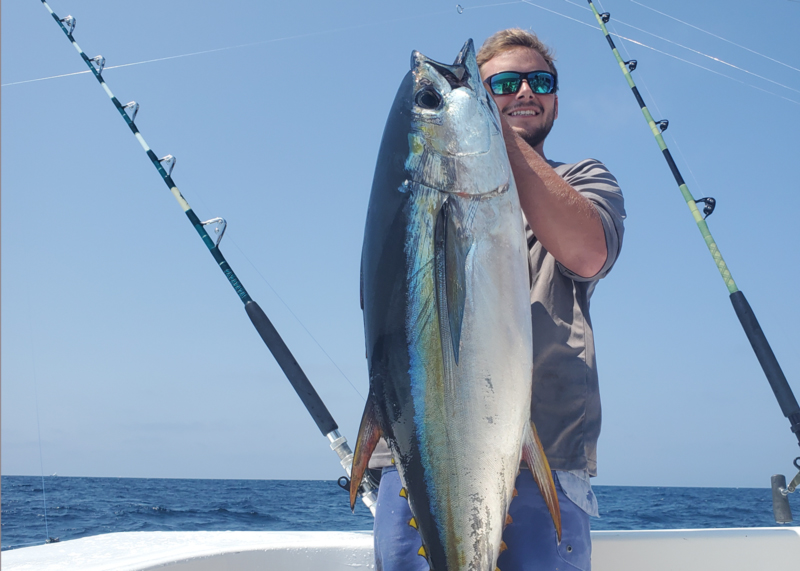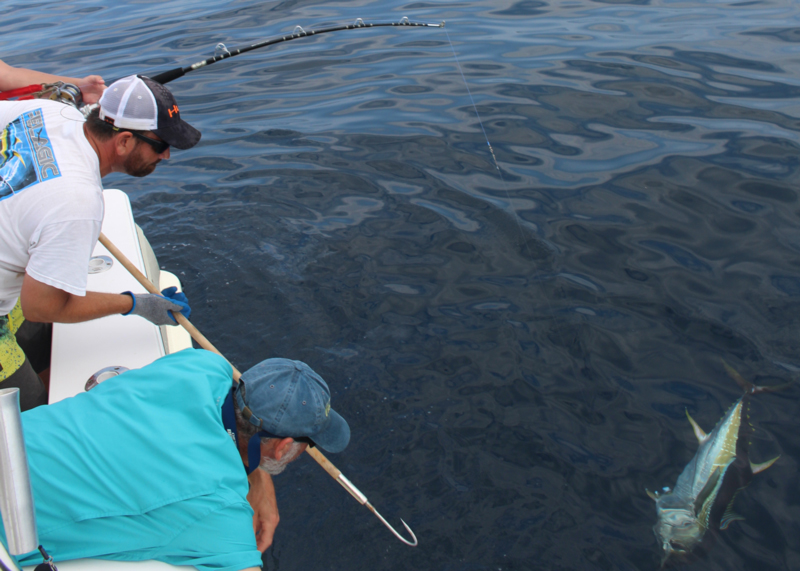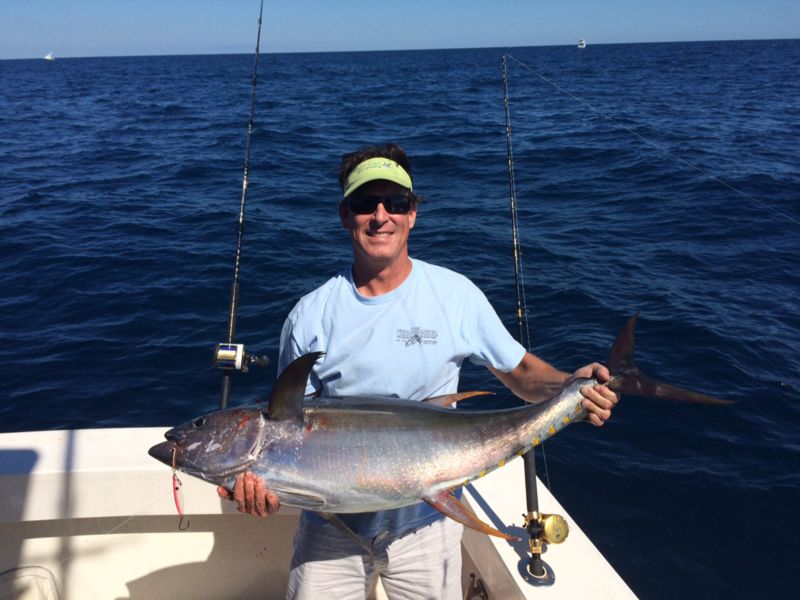Fishing for yellowfin tuna is often red-hot, or totally not. One day you can enjoy hookups by the dozens, and the next the ocean can seem completely devoid of life. The mid-summer month of July can be a particularly unpredictable time for targeting yellowfin, as some seasons they set up on the inshore lumps, other seasons they swarm at one particular canyon or another, and some Julys they seem to have disappeared from the planet. What July of 2022 has in store we can’t predict as we prepare this edition of FishTalk, but we know one thing for sure: if there are yellowfin within shooting distance of the inlet, these five tips will help you boost your catch rate.
- Be Prepared for Multiple Techniques
- Drop Leader Size
- Check SST Charts
- Keep an Itchy Trigger Finger on the MOB Button
- Consider Going Deep

Tuna Fishing Tip #1
Leave the dock prepared to apply multiple techniques on the same day. There will be times when the fish are on a trolling bite, others when chunking is the for-sure better way to hook up, and still others when jigging gets the job done. Sure, the fish will establish patterns and when you go to sleep the night before an offshore run you may well know that for the past week tactic X, Y, or Z has been the effective method. But when you shove off the dock in the morning there’s no telling if that will hold true.
True story: about five seasons back by all reports the chunk bite was non-existent, but boats that got out early and trolled all day were catching one to four yellowfin at the Washington. We set out with targeting those fish in mind but tossed a flat of butterfish onto the boat as a back-up plan; if the yellowfin proved to be uncooperative all day, we’d hack up some chunks and bail the lobster trap floats for mahi-mahi. After many fruitless hours of trolling, we began that hacking and prepped a five-gallon bucket of chunks. Then we cranked in the trolling lines and started heading for a line of floats. But before we got there we saw some splashing on the surface and diverted to it. Since all of our rigging had been switched over and the trolling gear was packed away, we threw a few handfuls of chunks over the side and started stripping back lines, just in case. In moments, one of the baits took off like it was attached to an underwater rocket. Long story short, for the next two hours we fought tuna nonstop. Six yellowfin were in the box and we released several unders plus bonito before it was time to head for the barn. And if we hadn’t had those butterfish aboard, we may well have gone home fishless.
Wait a sec — I know what you’re thinking: it costs too much to buy a flat of butterfish each and every time I set out for a day of trolling! Well, considering the cost of a boat, fuel, gear, etc. etc. etc., a flat of butterfish is just a drop in the bucket. And you’ll see other days when trolling is fruitless and chunks go untouched, but jigs catch fish. The bottom line? Be prepared for it all, so you can adjust tactics as necessary at any time.
Tuna Fishing Tip #2
Drop leader size. Most serious chunkers already know that there are times when a yellowfin won’t touch any leader heavier than 30-pound fluorocarbon. If you’re not familiar with this phenomenon, you’ve probably looked around at other boats with bent rods and wondered why you couldn’t buy a single bite. It can take a painfully long time to get a tuna to the boat with leader this light and yes, break-offs will happen. But sometimes it’s simply a must.

What many anglers may not realize is that going to a lighter leader can help when trolling, too. That doesn’t necessarily mean dropping all the way to 30, but if you’re towing 200-pound leaders try dropping to 120, 100, or even 80-pound test. You’ll notice that most lures (excluding spreader bars) have a heck of a lot more action with the lighter leaders, and in some situations this can mean a heck of a lot more strikes.
Tuna Fishing Tip #3
Check the SST charts. Naturally our favorite is SiriusXM Fish Mapping, since they’re FishTalk supporters. Plus, you can pull up the SST in high-res right at the helm, for the latest updates. Oh, and they also have fisheries biologists on staff who predict where the fish will be by species, then color-code it for display on your MFD screen. But regardless of how you choose to get your SST data, make sure you do in fact get it. Hearing some guy say “there’s a great temperature break just outside the Poorman’s” is virtually worthless, and can easily lead to a day of trolling in circles without ever seeing the temp gauge move up or down by a single degree. Those breaks concentrate fish, so make darn sure you know where they are.
Tuna Fishing Tip #4
When you get a knock-down instantaneously hit “MOB” on your chartplotter. Most anglers know they should do this, and most anglers remember about five minutes into the fight. This is a massive, critical mistake. Train yourself to punch that button the second the rod goes down, and whether you catch the fish or not, work over that area and all around it. Five passes over the same spot should be considered minimal.
Tuna Fishing Tip #5
When the tunas are on the inshore lumps and you’re not getting bites try fishing deep. Deep, as in right on the bottom. Sometimes shoals of sand eels will be in the last 10 or 20 feet of the water column, and the fish will stay down low as they hunt them. This happens more often with bluefin, but it does happen with yellowfin as well.
If you’re chunking, you can simply weight a line down with 10 or 12 ounces of lead (attached via a rubber band so it breaks free upon hookup) to send it deep. When the drift is fast and spinning baits becomes a problem, rig a naked ballyhoo and drop it to the bottom. Another option is to switch to using heavy jigs like 200-plus-gram Butterflies or diamond jigs, then mill around watching the fishfinder. When you see a cloud of bait down deep with a few larger marks nearby shift into neutral and drop the lines.

What will the tuna bite look like as summer hits this year? Who the heck knows? But we do know one thing: with these five tricks to your playbook, your chances of success will be better than they were last season.